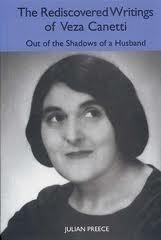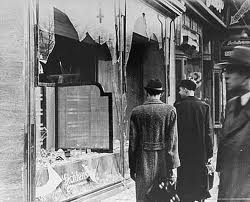“What is going on here is past hope. It may well lead to war, but how hard is that way out! The painter with his brush, the poet with his pen, the orator on the podium, they have all pointed out the horrors of war, and Man has understood…But then the violent criminal steps up. He stirs up the earth, he will always appear and destroy, because there will always be violent people. He who clings to the surface of the earth is doomed.”
In simple lan guage that sometimes takes on the cadences of the psalms, the soaring intensity of opera, and the beautifully repeated phrases of canons, author Veza Canetti tells the semi-autobiographical story of an artistic couple trapped just outside Vienna at the time of Kristallnacht, November, 1938, a terror she and her husband had also endured. The Canettis managed to escape from Austria just ten days after Kristallnacht, and immediately upon their arrival in England, Veza Canetti began to write this book. Using fictional characters, she fills the narrative with vibrant details from her own recent experiences, completing the “novel” in the spring of 1939.
guage that sometimes takes on the cadences of the psalms, the soaring intensity of opera, and the beautifully repeated phrases of canons, author Veza Canetti tells the semi-autobiographical story of an artistic couple trapped just outside Vienna at the time of Kristallnacht, November, 1938, a terror she and her husband had also endured. The Canettis managed to escape from Austria just ten days after Kristallnacht, and immediately upon their arrival in England, Veza Canetti began to write this book. Using fictional characters, she fills the narrative with vibrant details from her own recent experiences, completing the “novel” in the spring of 1939.
The main characters, Eva and her husband Andreas Kain, a Jewish writer, have been told that they will be shot if they remain in Austria, but they cannot leave—they have no visa for any other country, despite applications. Eva and Kain view the world differently from each other. Eva sees the cha nges in her Austrian neighborhood as terrifying, while Kain sees nothing of the violence and death. A poet who believes that if you like someone, that person will like you back, Kain’s naivete is partly responsible for the delay in their plans to leave. In the face of swastika flags appearing even on their own balcony, and their landlady’s announcement that they must vacate their apartment because a German couple plans to move in, Kain still goes to a local coffeehouse to read the paper, surprised when another patron points him out to the waiter, who requires him to leave.
nges in her Austrian neighborhood as terrifying, while Kain sees nothing of the violence and death. A poet who believes that if you like someone, that person will like you back, Kain’s naivete is partly responsible for the delay in their plans to leave. In the face of swastika flags appearing even on their own balcony, and their landlady’s announcement that they must vacate their apartment because a German couple plans to move in, Kain still goes to a local coffeehouse to read the paper, surprised when another patron points him out to the waiter, who requires him to leave.
Focusing on day-to-day life in a neighborhood in which Jews have always lived peaceably among their neighbors, the author emphasizes the human interactions and the major and minor tragedies which arise when the Nazis take over. By keeping the focus on the small and the immediate, the author emphasizes by contrast the monumental scope of the “cleansing,” which has affected thousands of similar, ordinary communities. Many characters, such as Kain, do not believe that the horrors can possibly be real. Educated and intellectual, Kain lives in an academic cocoon, protected from political and social realities. Kain’s brother Werner, a respected geologist, does not even believe that “there is such a thing as this Fuhrer.” Ironically, he has a visa, but, tied to the earth and his collection of rock treasures, he refuses to leave.
 Two Nazis manage to control nearly all aspects of their neighborhood life. The first is a German SS officer, who moves into the large villa where the Kains live to supervise the occupation and control the population, primarily through intimidation. The other Nazi is Baldur Pilz, an Austrian who is particularly proud of his “low number,” proof that he was among the first Austrians to join the Nazi movement. Both men are venal and ignorant, representative of a level of society that people like Eva and Kain have never known.
Two Nazis manage to control nearly all aspects of their neighborhood life. The first is a German SS officer, who moves into the large villa where the Kains live to supervise the occupation and control the population, primarily through intimidation. The other Nazi is Baldur Pilz, an Austrian who is particularly proud of his “low number,” proof that he was among the first Austrians to join the Nazi movement. Both men are venal and ignorant, representative of a level of society that people like Eva and Kain have never known.
Throughout the novel, the tortoise acts as a symbol of the Jews’ plight. When the novel opens, Kain brings home a small tortoise, which he “has rescued from humiliation.” In the city, he says, tortoises are being branded with swastikas, “burned for all time into their shells.” Because Kain has saved it, this small, but long-lived tortoise will not have to carry the swastika forever on its back, and it may even outlive Nazism. It can “live off not hing, off air, off leaves, needing only warmth,” and though vulnerable to vultures or wild animals, it can survive because of its “inner shell.” It is man who is the most sadistic towards the tortoise, cutting flesh off its living body to get tasty, fresh meat, cutting its heart out, or detaching its brain. Even then the tortoise can still go on creeping. It does not die quickly—unless it is deprived of warmth.
hing, off air, off leaves, needing only warmth,” and though vulnerable to vultures or wild animals, it can survive because of its “inner shell.” It is man who is the most sadistic towards the tortoise, cutting flesh off its living body to get tasty, fresh meat, cutting its heart out, or detaching its brain. Even then the tortoise can still go on creeping. It does not die quickly—unless it is deprived of warmth.
The immediacy of author Canetti’s own experience is obvious in small, homely details and realistic characterizations which bring this story to life. The contrast between the dignity of the betrayed Jews and the carnality of their oppressors contributes a stark elegance to this narrative of betrayals. A few moments of warmth and tenderness make the inexorability of the conclusion particularly heart-rending. Though this novel was scheduled for publication in 1939, Britain’s entry into the war prevented this, and it remained among Canetti’s papers after her death in 1963. Prepared for publication and released for the first time in 2001, sixty-two years after it was written, it has finally been released in paperback. (On my Favorites List for 2007)
Credits: The Kristallnacht photo is from http://www.jewishvirtuallibrary.org
